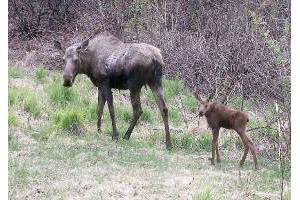Moose have a dense undercoat, and their hairs are hollow, giving excellent insulation against the cold. They will take refuge in the water of lakes and marshes during the summer to escape the heat and biting insects.
Photo Credit: Tim Bowman
Alces americanus
Common Name: moose
Other Common Names: elk (European)
Animal Guild: Mammal
Class > Order > Family: Mammalia > Artiodactyla > Cervidae
What does the species look like?
Moose are the largest member of the deer family. They can reach to 2.3 m (7.5 ft) tall on very long legs and weigh as much as 770 kg (1,700 lb). Their fur is brownish with some black and red. Both sexes have a large, overhanging upper lip. Males have a pendulous dewlap under the chin and from spring to fall, grow antlers up to 2 m (6.5 ft) across. The young are unlike other members of the deer family in that their coats are not spotted.
Where is the species found?
States & Provinces
AB, AK, BC, CO, CT, ID, MA, MB, ME, MI, MN, MT, NB, ND, NH, NL, NS, NT, NU, NY, ON, PA, QC, SK, UT, VT, WA, WI, WY, YT
Distribution
Moose are distributed across North America, Asia, and Europe. They are found largely in boreal forests, limited on the north by tundra and on the south by high summer temperatures. In North America, they occur in Alaska, the Rocky Mountains, the northern Midwest, and the northeastern states.
Moose prefer a mosaic of second-growth forest, wetlands, lakes, and streams. Their main foods are woody shrubs and wetland vegetation.
General Phenology and Life History
Moose may undergo seasonal movements to track available food. Antlers grow from spring to fall. They are used for display and combat during fall rut and shed in late fall and early winter. Young are born in the spring. Calves remain with their mothers for up to a year. Otherwise, moose are solitary animals.
Which phenophases should I observe?
Do you see/hear...?
Activity
Live individuals More...
For abundance, enter the number of individual animals observed in this phenophase.
Feeding For abundance, enter the number of individual animals observed in this phenophase.
Reproduction
Male combat For abundance, enter the number of individual animals observed in this phenophase.
Mating For abundance, enter the number of individual animals observed in this phenophase.
Development
Young individuals For abundance, enter the number of individual animals observed in this phenophase.
Dead individuals For abundance, enter the number of individual animals observed in this phenophase.
What do these phenophases look like?
There is currently no photoguide available for this species. If you'd like help us create one, use the guidance document and species template provided here . Then send it via email to education@usanpn.org when it is complete.
